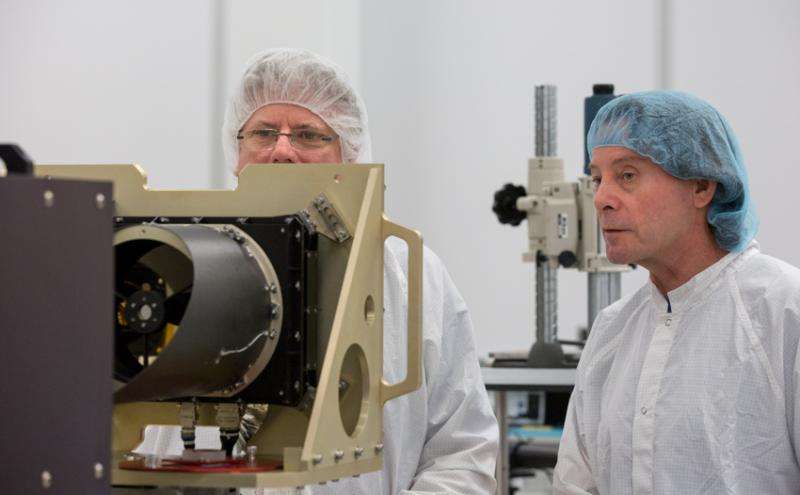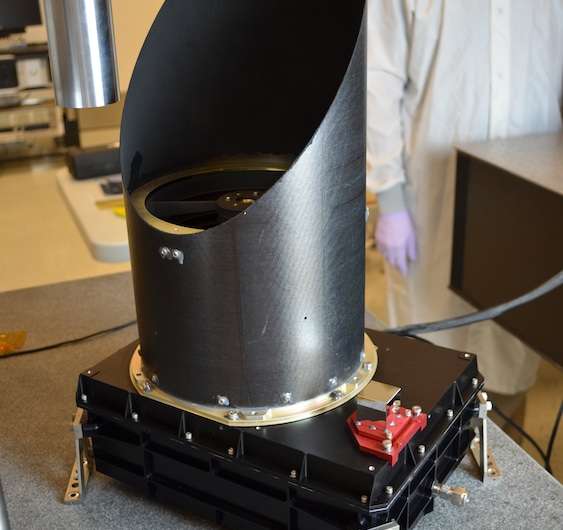Million-mile journey to an asteroid begins for ASU-built instrument

A journey that will stretch millions of miles and take years to complete begins with a short trip to a loading dock.
The OSIRIS-REx Thermal Emission Spectrometer (OTES for short) is the first space instrument built entirely on the Arizona State University campus. It forms a key part of a NASA mission to collect a sample from a primitive asteroid and return the sample to Earth.
About the size of a microwave oven, OTES has spent the past several years being designed, built, tested and calibrated. It has been bathed in rays to mimic the Sun's radiation, it has endured temperatures high and low, and it has experienced atmospheric pressures ranging from Earth-normal to hard vacuum.
Now after three months of round-the-clock testing, OTES is shipping out for the solar system.
"We're extremely pleased to have built this outstanding instrument here at ASU," said Philip Christensen, OTES' designer and instrument scientist. "Our weeks of testing and calibration have shown that OTES is of exceptional quality and sensitivity.
"We expect it's the first of many instruments to come from ASU."
Christensen is Regents Professor of Geological Sciences in ASU's School of Earth and Space Exploration. While his main research has involved Mars, Christensen said, "OTES is a direct descendant of two highly successful infrared instruments we've sent to Mars. These have mapped the rocks and minerals on that planet."
He explains, "The infrared is great for identifying minerals, and OTES will map the mineralogy of the asteroid's surface."

OTES is one of five instruments on NASA's OSIRIS-REx mission, and the first to be completed. OSIRIS-REx stands for Origins, Spectral Interpretation, Resource Identification, Security, Regolith Explorer. The mission is led by the University of Arizona in Tucson, and it is the third mission in NASA's New Frontiers solar-system exploration program.
The flight plan calls for the OSIRIS-REx spacecraft to launch in September 2016 and rendezvous with asteroid 101955 Bennu in August 2018, with a first sample-collecting attempt in October 2019. Bennu was chosen as a target in part because it is believed to be little changed from the time it formed, early in the solar system's history. Samples from it could improve our understanding of the origin of Earth's water and organics – both essential to life as we know it.
Touch and go
OSIRIS-REx will spend up to 15 months surveying Bennu's mineralogy and chemistry using OTES and another spectrometer working at shorter infrared and visible wavelengths. A visible-light camera suite, a laser altimeter and an X-ray spectrometer will complete the picture of the asteroid.
When mission scientists have chosen a spot on the asteroid to sample, OSIRIS-REx will approach the surface, touch it briefly and collect at least 60 grams (2 ounces) of dust, soil and rubble.
With the sample collected, OSIRIS-REx will cruise back to Earth and use a sample-return capsule to deliver the sample to a landing site in Utah in September 2023. Then after diverting past Earth, the spacecraft will go into orbit around the Sun.
Said Christensen, "After spending most of my career studying Mars, it's exciting and challenging to focus our attention on the origin and history of asteroids and the early solar system."
Provided by University of Arizona



















